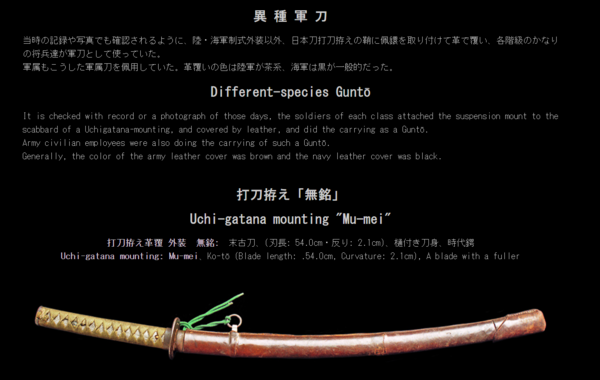-
Posts
13,783 -
Joined
-
Last visited
-
Days Won
169
Content Type
Profiles
Forums
Events
Store
Downloads
Gallery
Everything posted by Bruce Pennington
-
@Don sweet I thought Seattle had a Japanese sword club, but I cannot find it. @Scogg Sam, do you know of one? I did find one that meets in Vancouver. You are welcome to find a local sword expert. But we see many of these Damascus blades every year, and it is something used by the Chinese not Japanese sword makers. BTW, the signature on your blade is not Kuneshige. I don't recognize it at all.
- 10 replies
-
- 1
-

-
- gunto
- translation
-
(and 1 more)
Tagged with:
-

Nlf Gunto Discussion
Bruce Pennington replied to Bruce Pennington's topic in Military Swords of Japan
Out of 114 souvenirs on file, I have found that 21 of them have sarute. I didn’t do an exact measure of the styles, but they seem to be evenly distributed between high-quality style, plain metal like a type 95, and cloth. No way to know if these were part of the original manufacturer or added later by collectors. Three of them had the all brown tassel. -

Nlf Gunto Discussion
Bruce Pennington replied to Bruce Pennington's topic in Military Swords of Japan
Good one, Nazar! I didn't have that one. Thanks. -
It caught my eye that the company had shops in China. The painted numbering on the nakago looks modern, too.
-
Hi Jens, Others will know more, but while we wait, the logo on the nakago (tang) is the same as the Nakano Shoten: Nakano Shoten Located in Tokyo. This company was owned by Mr. Nakano. In addition to Tokyo, the company had shops in China. The company provided a full range of koshirae. The tsuka wrap is folded in the Japanese way - alternating fold directions. Chinese work usually folds in one direction. So, that seems legit. However the whole thing appears pretty new. One thing that bothers me is the bohi, or fuller groove on the blade. It starts too far down the blade from the handle and is not well defined, compared to Japanese work. My gut feel is that this is a modern reproduction. I don't know if Nakano is still operating, either.
-

Gunto with long Chounsai Emura mei
Bruce Pennington replied to Rawa's topic in Military Swords of Japan
Someone else may have a more defined idea of when the program started, but I've always heard late '41 to early '42. So, yeah, a Feb '41 would even predate that estimation. However, as I understand, it's just an estimate. One of the guys that focus on this, @vajo or @Kiipu or @mecox, etc, may fine tune that. -

Parade sword markings
Bruce Pennington replied to Michael McKie's topic in General Nihonto Related Discussion
Oops! Sorry, my Stamp-obsession got the best of me! Ha! -

Gunto with long Chounsai Emura mei
Bruce Pennington replied to Rawa's topic in Military Swords of Japan
Sam, For comparison, SMR/Mantetsu made between 38,000 and 50,000 swords, yet I only have 400 on file (which is not even 1 month's production amount) and I have been tracking them for years. I bet if you started a dedicated survey and searched the web for a few years, you'd find more than you have now. -

Gunto with long Chounsai Emura mei
Bruce Pennington replied to Rawa's topic in Military Swords of Japan
Marcin, My earliest observed star stamped blade is Feb 1941: STAR Blades 1. 1941, Feb Kochi Akikuni T98 Csymmes, NMB 2. 1941, Jun Gifu Kanetoshi, Murayama T98 Bangbangsan, NMB 3. 1941, Aug Yamagata Akiyoshi, Fujita T98 Stephen V, NMB 4. 1942, Feb Saga Masatsugu Ganko, NMB 5. 1942, Mar Gunma Kanetsugu RS Ganko, NMB 6. 1942, Spring Gifu Kanenobu RS Ganko, NMB 7. 1942, May Yamagata Akiyoshi, Fujita RS Crusader22, NMB 8. 1942, May Ehime Hiromasa Robin McLean, email 9. 1942, June Saga Masatsugu Na Ho on mune Shuriken, NMB 10. 1942, Jun Shimane Okimitsu IJASWORDS, NMB 11. 1942, Aug Akita Chikamitsu 406 Peter(C),NMB 12. 1942, Aug Saga Masatsugu Kapp/Monson,pg82 13. 1942, Aug Fukushima Shigefusa Ho on mune MeCox, NMB 14. 1942, Aug Tokyo Sukehiro 1525 Slough, pg 162 15. 1942, Aug Saga Yoshitada ebay 16. 1942, Sep Saga Kanemoto Na Ho on mune Zentsuji2, NMB 17. 1942, Sep Kumamoto Morinobu 94; Ho Ho mune 18. 1942, Autumn Niwa Kanenobu Slough 19. 1942, Oct Yamagata Akiyoshi 153 RS Worthpoint.ebay RS 20. 1942, Oct Gifu Kanenobu Slough -

Gunto with long Chounsai Emura mei
Bruce Pennington replied to Rawa's topic in Military Swords of Japan
Marcin, The army bought and collected swords from smiths all over the country, whether they were RJT qualified or not. Also, many private shops were making gunto fittings and selling gunto on the market. -

Help with Dad’s Bring Back SWORD!
Bruce Pennington replied to Slaborde's topic in Military Swords of Japan
Interesting. Also, the stamped number 26 would normally be seen on the seppa, as well. Well, Sara's dad brought it back, so like many others we've seen, we're left with a couple options. Either he found a sword that needed a tsuba and found a tsuba to put on it, or it was a replacement 'in the field.' -

Parade sword markings
Bruce Pennington replied to Michael McKie's topic in General Nihonto Related Discussion
Interesting with the "P Y" stamped in it! The "N" in diamond is an unidentified shop logo. -
Nice one, Calabrese!
-
More of a question for @PNSSHOGUN. I'm usually wrong when talking 94/98 differences.
-

Help with Dad’s Bring Back SWORD!
Bruce Pennington replied to Slaborde's topic in Military Swords of Japan
That's an interesting question, Mal. I have seen these in a wide variety of mixed civil/army fittings, and always have assumed they were carried by regular army officers that had brought their own sword from home to be fitted out for service. Or, I've imagined sword shops buying civil swords and re-fitting them with a variety of military parts to sell to officers. However, I've never actually heard or read who was allowed to carry them. I checked Ohmura's pages for this style. Sounds like he said that both officers and civil employees carried them: "It is checked with record or a photograph of those days, the soldiers of each class attached the suspension mount to the scabbard of a Uchigatana-mounting, and covered by leather, and did the carrying as a Guntō. Army civilian employees were also doing the carrying of such a Guntō. Generally, the color of the army leather cover was brown and the navy leather cover was black." In my survey of Gunzoku swords, I've found an equal number of fully gunto vs civil re-fit with the Gunzoku tassel. Part of the difficulty comes with these civil re-fit ones when they come with standard officer tassels (blue/brown and red/brown), because for years, the Gunzoku were permitted to carry regular officer's gunto with tassels. It was only the Uniform Regulation change of 1940 that assigned them the all-brown tassel. -

Nice Type 94 with Older Blade
Bruce Pennington replied to Eric_P's topic in Military Swords of Japan
John is selling a second/removable haikan (belt loop), if you are thinking of adding one -

Yasukuni strikes back.
Bruce Pennington replied to Rawa's topic in Auctions and Online Sales or Sellers
One thing that you learn after hanging around World War II swords is the phrase “never say never, never say always with World War II swords“. -

Nice Type 94 with Older Blade
Bruce Pennington replied to Eric_P's topic in Military Swords of Japan
Crimson missed military has some army menugi for sale: Miscellaneous parts -

Help with Dad’s Bring Back SWORD!
Bruce Pennington replied to Slaborde's topic in Military Swords of Japan
Ohmura’s site is free and has over 65 pages of fabulous examples of all the versions and types of WWII Japanese swords: Military Swords of Imperial Japan another great site: Japanese Sword Index you will find a page on the care and cleaning of your sword on that side as well. -
I've had someone on Warrelics ask me what a fair market value is for these. I realize it likely depends on style, age, condition, etc. but I don't follow them and was hoping someone could give me a range of pricing for the guy. Thanks!
-

Yasukuni strikes back.
Bruce Pennington replied to Rawa's topic in Auctions and Online Sales or Sellers
Isn't it as simple as the blade was re-fitted along the way? -
An interesting one posted by @Francis Wick HERE. Waiting for translators, but it seems the officer might have written his surrender info on the cavas cover:
-
That was a really good refresher, thank you, Thomas! Marcel, You nailed it. See Thomas' observation from the discussion in the other thread (click on the photo and it will be clear to read):






